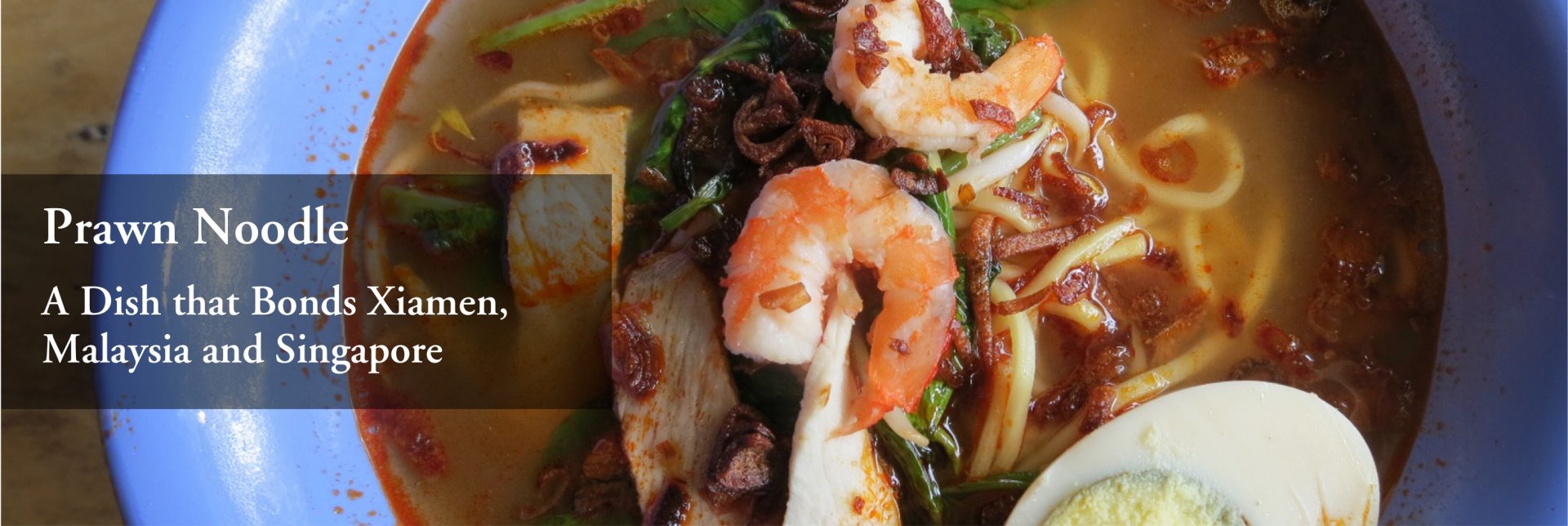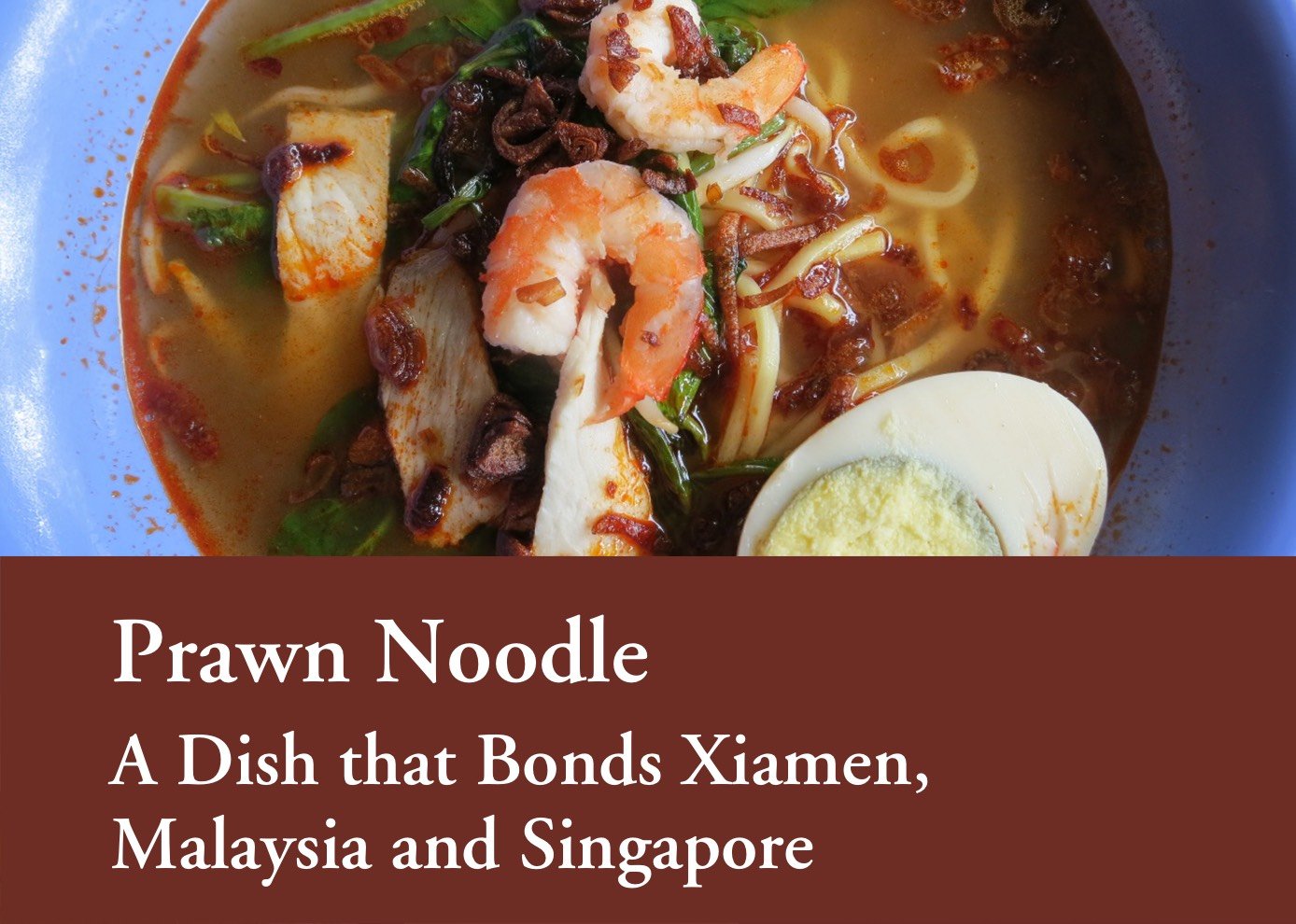Prawn Noodle:
A Dish that Bonds Xiamen, Malaysia and Singapore
Known as Hokkien noodle in Penang and prawn noodle in Singapore, yellow noodles served in a bowl of broth made by boiling prawn heads, shells and pork bones is a popular dish in Singapore and Malaysia. This dish originates from Xiamen (廈門), the port city of Fujian province in southern China and is known as Xiamen prawn noodle there.
Xiamen prawn noodle likely came to British Malaya during the peak of Chinese migrant labour arrivals between 1830 and 1930. At that time, China was in turmoil while the booming ports, mines and plantations of British Malaya were hungry for manpower. The prawn dish followed Fujian migrants wherever they went, with the largest concentrations in Singapore and Penang.

As the dish travelled from Xiamen, it took on local characteristics while retaining the essence of the dish - the prawn heads, shells and pork bones broth. Forms of Xiamen prawn noodle is still found in Malaysia and Singapore today. Indeed, the prawn noodle dish is firmly established as one of the street food staples of these two countries.
Interestingly, Xiamen prawn noodle, while still found in Xiamen, is not as ubiquitous and pervasive as compared to Singapore and Malaysia. In Xiamen, prawn noodle is a seasonal dish most popular during summer whereas it is popular throughout the year in Singapore and Malaysia.
Confucius said “不時,不食。”, which means "Do not eat food that is out of season". In Xiamen, prawns are at their best and most abundant during summer. Hence, Xiamen prawn noodle is also known as Summer noodle (夏麵). In Xiamen, the preferred prawn is whiskered velvet prawn (鬚赤蝦, also known as 狗蝦). In Penang, kuruma prawn (九節蝦) and sua lor prawn (沙罗蝦) are most commonly used. In Singapore, the favourites are red feet or “ang kar” prawn (紅腿蝦) and sua lor prawn.
In Penang, where 60% of the Chinese community are Hokkien (Fujianese), the dish is known simply as Hokkien mee (福建面) - it is one of the island's iconic street foods. In Singapore, where 40% of the Chinese are Hokkien, prawn noodle can be found in most hawker centres and coffee shops. There are even a few restaurants specialising in prawn noodle and they are doing thriving business.

In Xiamen, the signature broth is made with prawn heads, shells, pork bones and sometimes chicken bones as well. The prawn heads and shells are stir fried in a wok to release their flavors (爆香) before putting them to the boil for several hours. The resulting broth, rich in body and umami savory flavor is poured over blanched yellow noodles in a bowl. Common toppings in Xiamen include prawns, prawn balls, char siew (roast pork), pork intestine, and lean pork slices. The usual garnish is coriander and minced raw garlic is added for those who like a little spicy bite in their prawn noodle.
In Singapore, the prawn noodle dish is made in much the same way as in Xiamen by boiling prawn heads, shells and pork bones. Sauces like soy sauce and fish sauce complement the crustacean umami flavour of the prawn broth. Every prawn noodle hawker or restaurant has a "secret" recipe, which is usually a variation in the proportioning of the prawn heads, shells, pork bones, chicken bones, sauces, sugar and other optional ingredients like squid and dried anchovies.
In Singapore, the prawn broth varies in a spectrum from just prawn to heavy on pork (but prawn is always present). Today, the most popular are those with a balance of prawn and pork yielding a broth which is rich with a viscous body from dissolved pork tissue such as marrow and skin. Preferred toppings are now large fresh prawns and pork ribs / tail. Versions featuring lobsters and crayfish also have good responses from the public, especially among the younger crowd.
In Penang, the same prawn and pork broth remains the core of the Hokkien noodle dish, but sambal is often added directly to it during cooking. Sambal is a spicy hot relish made by cooking fermented shrimp paste (known as belacan in Malay) and dried and fresh chili pepper together. Besides blanched yellow noodles and bean sprouts, Penang Hokkien noodle always have kang kong (通菜, water spinach). Basic toppings are prawn, lean pork slices, fish cake slices and hard-boiled egg. Options include crispy roast pork belly, stewed pork knuckle, pork intestine, fish balls, etc. Penang Hokkien noodle spread across Malaysia, and it is the main style of prawn noodle from Johor Bahru to Kuala Lumpur. Once outside of Penang (including in Malaysia), the dish is known as Penang prawn noodle.

The Xiamen prawn noodle dish came to Nanyang more than a century ago. Like the Hokkien migrants who brought the dish to British Malaya, the dish has grown roots in Singapore and Malaysia, and flourished by adapting to local conditions. However, the dish may evolve and even appear outwardly different, the essential core of the dish – the prawn heads and shells broth –remained, connecting the dish to its origin in Xiamen. When the people of Malaysia, Singapore and Xiamen taste the different versions of prawn noodle, they will be able to feel the bond that remains resilient through the passage of time.
All articles/videos are prohibited from reproducing without the permission of the copyright holder.




Welcome to leave a message:
Please Sign In/Sign Up as a member and leave a message